Clacton on Sea as a holiday resort – Memories of the 1950s
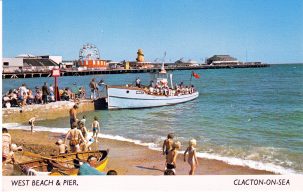
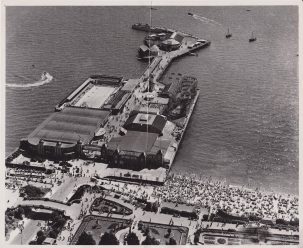
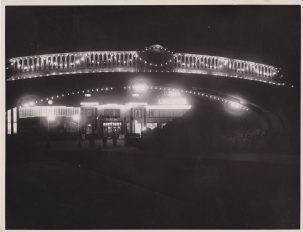
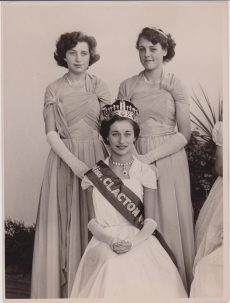
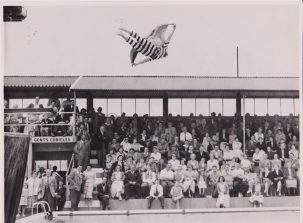
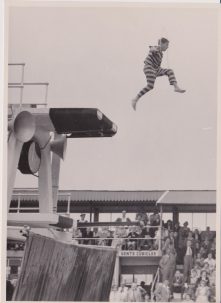
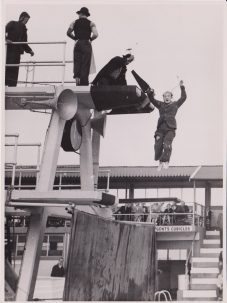
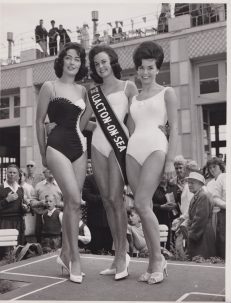

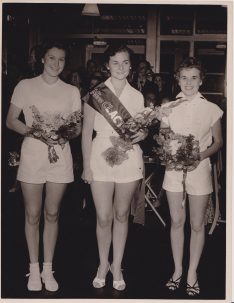
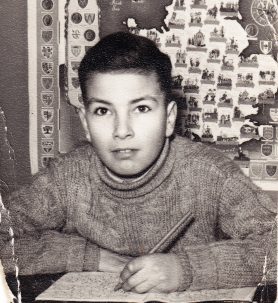
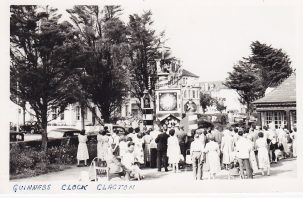
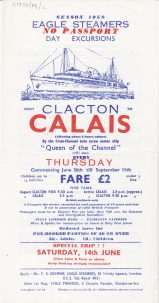
Arriving and Departing
The prime role of Clacton on Sea was to provide summer holidays for visitors. There was little employment in the town outside the holiday business. The holiday-makers came as day-trippers, or for either a week or fortnights holiday.
They arrived by rail, or by coach, or some still by the paddle steamers from Tower Pier, London. Few had private cars then. An Eastern National Coach Station was at Old Road, next to the Town Yard, and the Clacton Town F.C. ground. Visiting coaches parked for the day in Ellis Road, the Clacton Police Station is now on the site.
Arrival day was Saturday, and it was known as ‘Change over day.’ Those having completed their holiday left (and were encouraged to) by mid-morning; the newly arriving holiday makers were in the town by mid to late afternoon.
Local schoolboys acted as Barrow Boys, by being outside the railway station waiting to take luggage for visitors to their accommodation and hoping for tips. Always wishing that the accommodation would be close by! Arrangements were often made for the return trip to the station at the end of their holiday.
The visitors arrived white faced, but usually went home well tanned.
Accommodation ranged from hotels, guest houses, board accommodation (known as B&Bs today), caravan camps, and camping. Some of the caravan and camping places were quite a way from the sea front and entailed a long walk or bus ride. Many holidaymakers had not realised this when booking!
There were also coach and rail excursion trips for the day. When a train arrived, there was a flock of people walking down Station Road towards the sea front.
The Bank Holiday weekends of Easter, Whitsun, and the August Bank Holiday (which was at the beginning of the month), were massive, and the peak holiday weeks were the last week in July, and the first week in August, which of course included the Bank Holiday. The weather was critical for happy holidays, and being prosperous for traders, and the town itself etc. Clacton was noted for its cleanliness, and high sunshine hours.
The Summer Holiday
Clacton had a wide range of facilities to keep the holidaymakers entertained all week, with the sea, sandy beach, the pier, sea front gardens, sports grounds and facilities, cinema’s (Odeon, Century [Essoldo], and the Kinema Grand. Theatres, included: Princes Theatre, Westcliff Theatre, Band Pavilion, Savoy, and on the pier, the Jolly Roger, the Ocean Theatre, and the Rambla’s Concert Party (outside).
There were pleasure boats; The Viking Saga, and Nemo II, both operated by Dick Harman. A speedboat operated from the pier by Ernie Cobb, who was also the mechanic on the RNLI lifeboat, and which was stationed on the pier in the boathouse.
Day Trips to Calais
The MV ‘Queen of the Channel’, also gave ‘No Passport’ day trips to Calais, which took place on a Thursday. Also other trips from Tower Pier, London, and an afternoon local trip. The arrival, and departure of the M.V. ‘Queen of the Channel’, which could carry 1,500 passengers, was quite a sight, especially when arriving back from its day trips to Calais late in the evening ablaze with lights.
Coach Excursions
Many holidaymakers took a coach excursion from the Rosemary Road coach stand. Eastern National. Barnes, and Suttons etc. were other operators. Trips were to: St Osyth Priory; Harwich & Dovercourt; Flatford and Dedham; and Colchester Castle. There was also the Mystery Trip, where the route was known to the coach driver only.
The town was busy all day and evening. In late afternoon the holidaymakers left the beach etc. to return for tea, evening meal, or dinner depending on the type of accommodation. They then went out again in the evening for a walk along the promenade, or to go to a theatre show. When the shows finished many hundreds of people were about again. Decorative lighting added to the different atmosphere of the evening, especially later in the season when dusk came earlier.
The Popular West Beach
The West beach next to the pier was the most popular for holidaymakers. Here was a Punch & Judy show, morning and afternoons. A photographer, Lester Keeble, had a small wooden hut on the promenade just by the Pier Gap. He would approach people and take their photograph to buy as a holiday souvenir. Some refused; so not to waste film, he never actually took the first shot, but waited until he knew he had an interest. The developed photographs were collected later in the week.
There were two diving rafts moored in the sea, they were painted white. With the tide going out, there might have been a problem with shallow water, but I don’t remember any injuries. On the West Beach was a Punch & Judy Show, and a wooden collection box was taken round for donations at the end of the performance but many left before the box got to them! Similarly, along the cliff top were white painted fold-up metal seats with wooden slats to sit on. They were owned by Clacton Urban District Council, and had 3d painted upon each one. A collector with a white coat, peaked cap and a leather bag on a strap across his shoulder walked along and collected the fee due, but many got up quickly and left as the collector approached!
Butlins Holiday Camp
Butlins Holiday Camp was a major part of Clacton, although many campers spent the whole time on site. It was said that Butlins discouraged their visitors from going out of the camp, as everything they needed was on the camp. However the distinctive Butlins Tandem bikes were frequently seen along the seafront roads.
Pleasure Flights from Clacton Airfield
Beyond Butlins, on West Road towards Jaywick, was the Clacton Airfield. Pleasure Flights could be taken here in a small Auster high wing aircraft. Captain Jim Crampton gave the flights and a small yellow certificate was given to those who participated.
Clacton Carnival
A major event of the summer season was the Clacton Carnival week, with the highlight being the procession and which was held on a Wednesday afternoon. The carnival was held during the first week of August. Prior to all this was the Crowning of the Carnival Queen and her two Princeses, which took place at the Band Pavilion. Ronnie Mills (conductor of The Ronnie Mills Band) was usually the compere. There was also a firework display during the week, which culminated in the Queens head (QE II) displayed in fireworks. This was at the Vista Road, Recreation Ground. The Clacton UDC staged an annual Ideal Holiday Girl beauty competition, usually at the Band Pavilion. This complex opposite the Royal Hotel, had a sunken open auditorium. For events held here, crowds stood around the perimeter at ground level for free, and this had a detrimental effect on the numbers paying for a seat.
Clacton Pier, Number One North Sea
The pier was located in a central position of the sea front and was a key attraction. Barney Kingsman with his beret, the son of the owner (Ernest Kingsman d. 1942) was a familiar figure. Entrance to the pier was 2d via turnstiles. Rides popular were the Steel Stella; Dodgems, Speedway; the Peter Pan Railway; the Mirror Maze; a Helter-Skelter; and the Ghost Train – here in the dark were strips of muslin hanging down which brushed across ones face, and causing screams!
Large Jockey Scales with chromed barley twist framework was popular for checking one’s weight. The swimming pool was initially the only one above the sea in the world, but the water was always said to be quite cold. Part of this area of the pier was the elevated Queen Mary Sundeck where a tan was a result of sitting in the deckchairs. There was a line of shelters with seats along the central section of the pier. The Holland side was popular for the morning sun, and the Jaywick side for the afternoon sun.
The Ramblas Concert party performed twice a day outside with the audience sitting on deck-chairs. The area was surrounded with canvas screens secured to metal uprights to screen the people from the wind. People peered through the gap where the canvas was attached to the uprights to watch. There were many ‘Penny in the Slot’ machines with different mainly ball games. Ice-creams could be brought, Walls and Eldorado were the leading makes; and Candy-Floss coloured white and pink created in a spinning metal bowl, the strand being caught onto a brown paper tube and wound around until the right amount had been gathered.
Pleasure Boats
The Commodore, a former converted WWII M.T.B., also gave trips from the pier, and sometimes the paddle steamer, Medway Queen visited the pier berthing arm. Stationed on the pier was the RNLI lifeboat, housed in its boathouse, and named the Sir Godfrey Baring. This boat when new was displayed at the Festival of Britain held in London during 1951 before coming on station at Clacton. To summon the crew, two maroons were fired. Upon the boats safe return, a single maroon was fired. The boathouse was open to visitors. To witness the launch was an exciting occasion, the sound of the maroons also caused excitement, and when not at school, we would race to the sea front to watch the launch, and we always expected to see a large ship sinking off shore!
The Blue Lagoon
The Blue Lagoon dance hall at the pier entrance on the right, and was a great attraction. The dance band was under the direction of Teddy Dobbs, who had been the resident dance band leader from before the Second World War. (His son was one of my school teachers). The pier opened for the Easter holiday, then closed until re-opening for the Whitsun holiday and then remained open daily until the season closed towards the end of September. It was a short season, but the whole economy of the town relied on those few short summer months.
Entertainment and Holiday Activities in Clacton
Pier Gap, a cutting through the cliff to gain access to the pier and lower promenade, was spanned by the Venetian Bridge. This was a popular view-point for holidaymakers, and myself, to watch all the busy activity. On one side the pier entrance could be seen and some of the rides in operation, the pleasure boats coming and going and part of the beach, and beyond the far sea horizon. Sometimes in great clarity, other times less so, and occasionally obscured by a coastal rainstorm. The opposite side was a view looking along Pier Avenue and thronged with people coming and going, and the fun of the amusement arcades.
The sea-front gardens were an attraction and made a separation from the cliff top and the Marine Parade road. The war memorial gardens were the most spectacular for the flowers (as they still are to this day) but the gardens were not entered by visitors, the gates kept closed unlike today. It was still seen as a solemn place with memories of war and loss still poignant.
Adjacent to the road here, horse drawn landau’s plied for hire for rides along the sea front in old fashioned luxury. Close to the West Greensward was a model yacht pond, popular with boys and girls alike. All along the front were shelters of a variety of designs. The Guinness Clock which was activated every quarter of an hour and on the hour, produced all sorts of wacky items and sounds and attracted large numbers for every free performance. The Palace complex, which was rather ‘run down’ had a bar, café and a Louis Tussauds waxworks exhibition, entitled ‘From D- Day to Victory’ Nearby at the Martello Tower was a model village display in the moat (which was dry of course.) No access into the tower was possible for visitors. The Easter National Omnibus Co. operated a single, and double deck service on their green buses. An open top bus service with cream coloured buses ran along the sea front in summer. These were older buses adapted for the purpose, but were very popular with visitors sitting on the top deck letting the wind blow through their hair. The driver and conductor had a summer and winter uniform.
Restaurants and Tea Rooms
There were all types of eating places, from fish and chips to more traditional roast lunches. Prime among these establishments was Cordy’s Restaurant opposite the Band Pavilion. Lunch was in two or sometimes three sittings, and long queues patiently waited for a table. Silver service with smartly attired waitresses was the standard. Afternoon tea was also very popular with tiered cake plates. Cordy’s chocolate éclairs were legendry, with many people claiming they could never be surpassed. Other places to eat were the Criterion Restaurant, The Geisha, while in the town was Nan’s Tea Room, and Davey’s who were noted for accommodating parties. The sea end of Pier Avenue had Marshalls amusements and similar amusement arcades, while gift shops for souvenirs and the like were Spalls, and the appropriately named Gift Shop.
During the mid afternoon, the London evening newspapers, the Evening News, Standard, and The Star started to arrive by train and vendors sold these from their stands around the town; the papers were much sought after, especially from those who lived in the London area. Cricket scores, and racing results were closely scrutinised. One stand was at the sea end of Pier Avenue, and another was in Station Road, at Wagstaffs Corner. There were one or two editions.
Style of holidaymakers and visitors
The summer season was typified by the different types of visitors. During the school holidays, families predominated; while the early and later parts of the season more mature visitors predominated. Additionally, Clacton had several convalescent homes, and some of their patients were to be seen taking the recuperative sea air, being wheeled in bath chairs, or in spinal carriages. Sadly also, some who were suffering from ‘shell shock’ from the recent world war. Those convalescing also had holidays and which were mainly taken early or late in the season.
During the summer season, the town had a great feeling of activity and crowds of people. For those visitors, it was their one chance of a break from their daily routine, to visit the seaside and experience a different world from their home life in post-war austerity Great Britain.
Clacton during the winter months
A feature of living in a seaside town was the contrast between the summer season, and the rest of the year, thus during the long winter months, the town was dead, especially for us youngsters! The Pier Avenue shops and amusement arcades from West Avenue to the Marine Parade all closed, and was quite deserted of pedestrians. The delicate shrubs/palms trees at the war memorial gardens were wrapped in hessian sacking to protect them from the harsh winter winds.
The tall flagstaff near the Band Pavilion was used to provide warnings of gales for mariners – there was still trading by barges along the coast. A black canvas cone was hoisted up the flagstaff. If a northerly gale was expected, the cone hung point up, and the opposite for a southerly expected gale. The Clacton UDC had a weather station near the entrance to the Martello Tower. ‘Young’ Harry Clark recorded the daily readings. The sunshine and rainfall readings being particularly important for the official holiday guides to be prepared for the following year, the town usually having low rainfall and high sunshine levels. A Barograph which visually recorded the air pressure, was located near the War Memorial Gardens for public viewing during the summer, and the showing the weeks weather readings, and also the forecast, which was hand written, was displayed here for the holidaymakers, and residents alike.
Some businessmen involved in the holiday business spent the winter abroad, on the proceeds of the previous summer season takings. Shops did little for the Christmas trade, and there were few seasonal decorations. The town almost went into hibernation during those long winter months. As Easter approached each year preparations were made to welcome the holidaymakers once again, it was a time of great anticipation in the town.
This description of Clacton during the 1950s was the typical yearly routine of most of the seaside resorts of Great Britain at this time before most had the aspiration or abilities to travel abroad. This was to be ahead into the 1960s, which itself was to be a decade of great social change. The 1960s was to see the gradual decline of the traditional British seaside holiday.
The writer, Roger Kennell, actually lived at Holland on Sea as a young boy, but this place was all within the general Clacton on Sea area.
East Anglian Film Archive: ‘Back to the Sun at Clacton-on-Sea’
The East Anglian Film Archive has a film entitled: ‘Back to the Sun at Clacton-on-Sea’ and can be viewed on the EAFA website here: http://www.eafa.org.uk/catalogue/209
Summary: A guided tour to summertime at Clacton-on-Sea, 1962, hosted on the East Anglian Film Archive website. The opening shots of this film show the beach and promenade in close season. The audience is introduced to its guide and commentator, a local boatman. The scene moves to Clacton Airstrip, where pleasure flights are offered to tourists. A group enters a plane and there are aerial shots back along the four miles of sea front at Clacton. The public gardens feature with their displays of tulips. There are shots of the town centre and the local fish is highly recommended. This leads into a sequence advertising local amenities. Clacton Angling Club offer a day’s fishing off the pier. A man is shown landing a skate.







Comments about this page
Miss Clacton 1952 in your picture is my lovely mum, Joan Stock. Nice to see the photos preserved
Reply to Sue on post 12.6.23.
Portland House Hotel is still standing but has been converted into flats.
My parents used to own it when you stayed there in the 60’s.
I was a schoolboy in the early 50’s in Clacton. I attended Pathfields secondary school.
I managed to catch Polio and it was attributed to the Swimming pool on the pier. Fortunately it did not affect me badly.
I entered the RAF in 1957 and only returned to Clacton occasionally to visit my mother
I lived in Clacton aged about 5-10 in around 1961-1966 so my memories are obviously from the perspective of a child. A lot of what you say chimes with me, but I don’t really recall the place being quite as dead in the winter as you describe it nor there being wide-scale unemployment out of the summer season. I remember there being a vibrant town centre in the area where the bus station was which served as a shopping centre for the town and nearby villages and it was always very busy on Saturdays all year. Yes, I remember if you went down from there towards the pier in the winter, it was like a ghost town. And I remember the delights of the amusement arcades when they were open in the summer. As to there being little work outside tourism, well, my dad was an all-year bookkeeper at Butlins and one of the lucky few to be employed permanently by that company, so perhaps QED. Apart from the general service sector, I am scratching my head as to what other employment would have been available, but I remember all my school friends’ dads having a permanent job of some kind. London was in commuting distance, which may have helped. This was also a time of low unemployment in the UK.
PS – I went to Alton Park Junior School. Maybe somebody remembers me.
Happy memories of staying at The Portland Hotel. Does anyone know if it is still standing?
Had a great holiday there and always wondered what became of the nice young lady who sold ice cream from her mobile push along unit. We all had a group photo of us with her next to the pool and still have it to this day. Sad to think that Butlins Clayton is now no more but I still have all the great memories.
I was born in Holland on Sea in December 1948 we live there until 1960. I went to Holland on sea primary school and then Clacton boys, technical school I was in the boys brigade and also a barrow boy. I have fond memories of growing up in Clacton and had a friend whose father Worked in Butlins so had Entry for free most summers. Anybody know Alan Sage, and Martin Griffith From Holland
Lots of memories from growing up in Clacton during the 1950’s and 1960’s – especially the “Mods and Rockers” visiting the town. I always remember Sid in Marshalls Amusements who used to run the bingo and with his catch phrase of “who said that” when someone called out “House”.
My Grandfather, (Stanley Barker Smith) used to own a gents outfitters shop on Station Road, Clacton. His daughter ,Shirley, (my Mother) had her first job at Butlins Holiday camp as a wages clerk, and did meet Billy Butlin often. Mum later went to Leamington Spa and married my Father, but later, (when I was 12, I am now 75) divorced my Father and remarried George Kethro who managed three small kiosks on Clacton pier.( A news agents ‘under ‘The Jolly Roger Theatre’; A souvenir Gift kiosk close to the ‘Mirror Maze’, and a Chemists Sundries kiosk opposite The Steele Stella). My Mother,(Shirley) returned to Clacton and married George Kethro in 1960, and for a further 9 seasons they worked the kiosks; Mum, in the souvenir kiosk, George in the Chemist’s Sundries, and my Grandmother in the newsagents, together with George’s daughter (Vera Kethro) who mostly ran the newsagents,(my Gran, just for a few seasons). My Mother survived until last year (2021) and died, aged 99, in a Derby Care Home.
Bob Smith, Borrowash, Derby.
I was born in Clacton in 1947 and lived there until I married in 1970. My mother and her family lived there earlier in the 20th century and during the war years. Lots of memories and fun times, and particularly the mods & rockers in the 1960’s – and of course playing the flipper machines in Marshalls Amusements in Pier Avenue! I also recall that my grandmother was one of the first people in Clacton to have a telephone – and her number was Clacton 2. I believe it was the Cook & Eaves shop in Pier Avenue that had the number Clacton 1.
Letting the Butlins Camp site go was a disaster for Clacton. It could have been developed into a modern entertainment centre . Now Clacton is dead with no real facilities or entertainment for visitors. The town seems to have rolled over and just given up
Our Mother was from Clacton so we used to come there each summer to visit her family which we always felt was half the population of the town. We usually came on the steam train. I remember being told off for drawing with my finger in the dirt on the carriage window sills! Our days were spent at the beach. We had two routes down there, one by Old Road down to Pier Avenue and the other down Coppins Lane to Rush Green and finally on to Jaywick. On the latter route there were Rowan trees and we delighted in squashing the berries as we walked. Evenings were busy with visits from our aunts, uncles and cousins, many of whom still lived in Clacton. Near our Grandparents house was a large Dr Barnados facility and we used to talk to the kids there through the chain link fence. Later that building was turned into flats and we had an aunt and uncle living there. One of our aunts lived in Lake walk and we would meet her from the bus. As we walked back with her we would watch the street gas lamp lighter at work! Your article has triggered many memories, all of them happy! Many years later I returned to Clacton with my Mother and was amazed at how small it looked. It certainly didn’t seem small as we walked around it as kids! I hope the town has survived all the changes and prospers now!
I lived in Agate Road from late 1940’s until 1957. I remember the Ramblas Concert Party on the pier because I entered the talent competitions during Summer school holidays. Johnny Condon (Brian Condon’s Brother) played the spoons on one of the shows and went on to appear on Hughie Green’s TV talent show Opportunity Knocks. I have wonderful memories of Clacton.
Clacton -On-Sea was a very very proud town, yes it had to change more so since Butlins left, but you still fill we do not produce as much , why no horse drawn carriages ? Put back the Guinness clock come on Clacton the pier is doing its very best
Fascinating account of Clacton, thank you! I actually stumbled across the website which came up when I was googling some more about Betram the Clown (after seeing a film in the EAFA).
Add a comment about this page